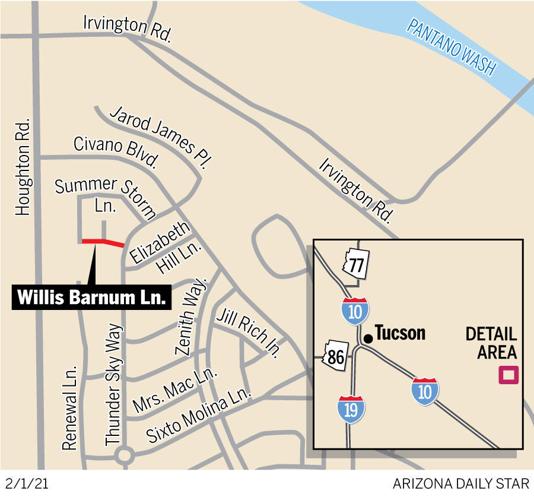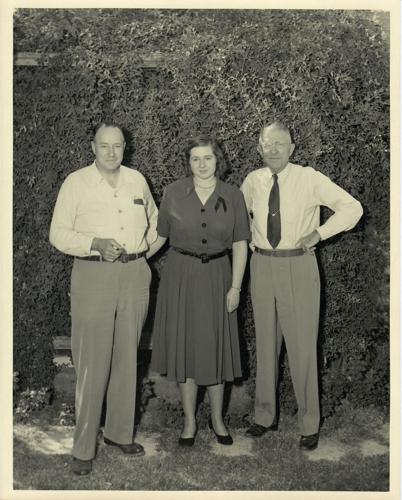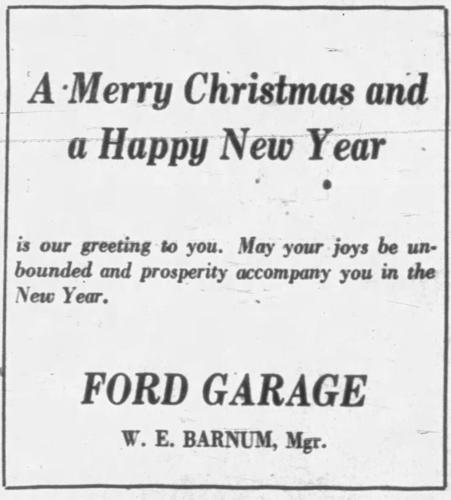Willis E. Barnum Sr. is remembered today in Tucson with his name not just on a hill in Reid Park, but on a Mount Lemmon lookout rock and an east-side city street.
He was born to Willard W. and Addie (Johnson) Barnum on April 4, 1880 in Holley, New York.
Eugene, as he was known, graduated from Albion High School in 1899, where he played football either for the high school or a town team.
Next he attended Cornell University for two years, studying law, but he dropped out due to bad eyesight. He may have also played football here.
On Oct. 29, 1902, he married Laura J. English at her parents’ home in Albion, New York. The bride had graduated from high school with Barnum before attending Elmira College in Elmira, N.Y.
The following year, Barnum moved to Tucson, where he was employed as a conductor by the Pullman Car Co.
In April of that year, his wife arrived in the Old Pueblo, and the couple resided at 134 N. Stone Ave.
A couple of weeks later, she is known to have been spending time in Guaymas, Sonora, likely due to the fact Barnum’s train route traveled from Tucson to this Mexican port city.
The couple had their only child, Willis E. Barnum Jr., sometimes called Barney, on Jan. 12, 1904 in Tucson.
The same year, Barnum bought or had a house built at 234 E. Fourth Street from Preston N. Jacobus, one-time mayor (and the namesake of Jacobus Avenue).
Laura Barnum also seems to have gotten into real estate by the next year, buying property along Sixth Avenue north of downtown.
On one of his many days on the train, Barnum met a man who led him to become interested in mining.
Soon after, Barnum joined the Black Mountain Mining Co., working in Sonora. In April 1908, Barnum and family relocated from Tucson to Pachuca, Hidalgo, Mexico, 60 miles northeast of Mexico City by railroad, so he could act as superintendent of mining operations there.
In 1914, Barnum’s time in Mexico came to a sudden end, as a result of the Tampico incident, an international incident between the U.S. and Mexico.
It began with the arrest of unarmed American sailors, said to have been in a prohibited area, and ended for Barnum, at least, on an English-captained Mexican ship named Esperanza, chartered by the U.S. government to bring citizens back home.
After returning to the Old Pueblo, Barnum had a brick dwelling built at 821 E. Fourth Street.
In 1917, after the United States entered World War I, Barnum, along with many other well-known Tucsonans such as George O. Hilzinger, Fred Velasco and Stanley J. Kitt, signed up for the state militia but likely never saw any action.
Laura Barnum helped the war effort by sewing bandages at the Daughters of the American Revolution service organization meetings. Soon after, their son Willis Jr. was sent to military school in San Diego.
By the following year, Barnum was working as manager of the accessory department at the Ford Garage, which was part of the Ford Agency owned by Monte Mansfield (namesake of Mansfield Park).
Over the next few years, he would appear in the local newspapers, giving automobile advice to readers.
In his spare time, away from auto part sales and real estate, Barnum served on the Tucson Council of the Boy Scouts of America, with James M. Lawton as president, along with many other prominent Tucsonans. Barnum was scout commissioner.
In March 1921, a local council committee began looking for a site for a permanent summer camp. Even though the government had set aside 10 acres for the Scouts in White House Canyon (now called Madera Canyon) in the Santa Rita Mountains for camping purposes, they chose to search on Mount Lemmon.
By June 1921, they had located a site on the south slope of Mount Bigelow and named it Camp Lawton for the council’s president.
By July 1921, a large rock formation, just northwest of present-day San Pedro Vista, was named Barnum Rock for the commissioner. This rock, with its great views of the surrounding mountains, was used by scouts as a fire lookout.
The following month, it was announced in the newspapers that Barnum was leaving Tucson to reside in Safford and take over the Ford Agency of Graham County. Here he would sell Ford cars and Fordson tractors.
In 1926, the Barnum family returned to Tucson to live. They were involved in the house construction business, including building their own home at 1810 E. Fifth St.
In 1928, their son Willis Jr. graduated from the University of Arizona with a degree in mechanical engineering. He married Margaret “Peggy” Christy of Phoenix. They would have daughter Patricia Christy Barnum.
By 1934, Barnum was serving as a member of the Greens Committee for the Randolph Park Golf Course, under city auspices, a role he would stay in for many years.
In 1937, Barnum, along with Lautaro Roca, opened the Miracle Mile Addition, a subdivision enclosed by present-day Grant Road, Oracle Road, 15th Avenue and Glenn Street.
In 1940, Barnum volunteered to be chairman of the Pima County Draft Board No. 2 as America began preparations for possible involvement in World War II. One of the board members at that time was J.F. McKale (namesake of McKale Memorial Center).
Barnum would serve in this capacity throughout the war, spending hours of his free time making the tough decisions of who went and fought and who got an exemption.
Part of his job was to decide who among the prisoners of the Federal Prison Camp No. 10, at that point constructing the Mount Lemmon Highway, were fit to fight.
Barnum would continue in this role long after WWII and the Korean Conflict ended, and it may have been his most important contribution.
In 1955, Barnum was honored with an official resolution for his many years of work with the city Greens Committee: “... He hereby is publicly commended for extraordinary service to the community for which the city desires to express for him its respect and gratitude.”
Barnum died at age 91 in 1971.
In the late 1990s or early 2000s, with the help of Virginia McBride, family member Willis Barnum Lane was named in the Civano neighborhood on Houghton Road.








